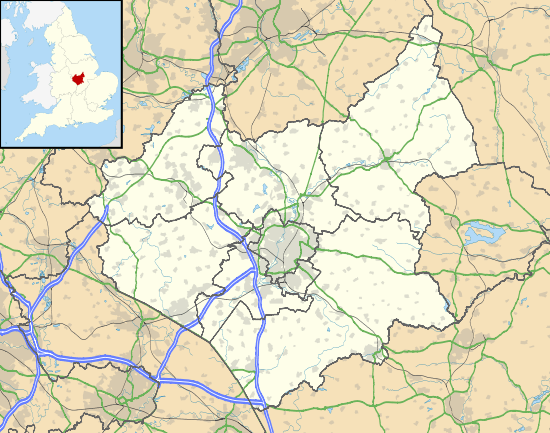Bruntingthorpe Aerodrome
| Bruntingthorpe Aerodrome | |||||||||||||||
|---|---|---|---|---|---|---|---|---|---|---|---|---|---|---|---|
 | |||||||||||||||
| IATA: none – ICAO: none – LID: EG74 | |||||||||||||||
| Summary | |||||||||||||||
| Airport type | Private/Unlicensed | ||||||||||||||
| Operator | C Walton Ltd | ||||||||||||||
| Location | Bruntingthorpe, Leicestershire | ||||||||||||||
| Elevation AMSL | 467 ft / 142 m | ||||||||||||||
| Coordinates | 52°29′13″N 001°07′50″W / 52.48694°N 1.13056°WCoordinates: 52°29′13″N 001°07′50″W / 52.48694°N 1.13056°W | ||||||||||||||
| Website |
www.bruntingthorpe.com www.bruntingthorpeevents.com | ||||||||||||||
| Map | |||||||||||||||
 Bruntingthorpe Location in Leicestershire | |||||||||||||||
| Runways | |||||||||||||||
| |||||||||||||||
Bruntingthorpe Aerodrome and Proving Ground (IATA: n/a, ICAO: n/a) is a privately owned airport in Leicestershire near the village of Bruntingthorpe. It was opened as RAF Bruntingthorpe in 1942.
History
The aerodrome was formerly RAF Bruntingthorpe which hosted both the Royal Air Force and the United States Air Force during its life.
Current uses
Vehicles
The site became privately owned by the Chrysler Motor Corporation in 1973, and was then used for high-performance car testing, the testing of other vehicles, and vehicle storage. These activities still take place under the ownership of the Walton family company, the former airfield having been bought from Peugeot-Talbot (Chrysler's successor), in August,1983. Various circuits are available, from 4.2 miles (6.8 km) to 0.9 miles (1.4 km) loop; or the former runway, just under 2 miles (3 km) long.
As well as vehicle testing, Bruntingthorpe offers storage of cars and aircraft, film production facilities, and military/civilian defence testing. Within the airfield is a repair facility for Ferraris and Maseratis. The site benefits from planning consent for Proving and Testing of Vehicles.
Aircraft
Bruntingthorpe houses the Cold War Jets Collection aircraft museum with about thirty-five aircraft from that era.
Vickers VC10 C1K XR808 "Bob" arrived at Bruntingthorpe on 29 July 2013 after retirement from the RAF and has now moved to RAF Cosford to join their museum.
In March 2013, the last RAF Lockheed TriStars were retired into the aerodrome. GJD Services have been keeping the 6 planes under a storage and maintenance programme. They have been bought by AGD Systems Corp and may be available for use by NATO, the RAF and the USAF. GJD Services are maintaining the aircraft in full airworthy condition. The first Tristar will leave Bruntingthorpe at some point in the future. The last VC-10 to fly (ZA147) is currently at Bruntingthorpe. Its future is unknown.
Beech Restorations restore aircraft to flying condition. Permanently based at Bruntingthorpe will be Beechcraft Model 18, G-BKRN a North American T-6 Texan, G-TOMC, and a Cessna 120. Another T-6, G-CCPM, ex Canadian AF, is being restored to flying condition, and there are two others waiting restoration, as is a Fairey Battle.
The most notable aircraft at the aerodrome was the Avro Vulcan XH558, which was restored to airworthy condition over a period of eight years at a cost of about GBP6,000,000. Its first flight was from Bruntingthorpe on 18 October 2007. The Vulcan left Bruntingthorpe at the beginning of the 2008 flying display season, was temporarily based at RAF Brize Norton as a flying base, and RAF Lyneham as its winter maintenance base. It is now grounded and permanently based at Robin Hood Airport, Doncaster, formerly RAF Finningley 'V Bomber' base.[3]
1997 Boeing 747 Explosion Test
In 1997, the airfield was used by the Federal Aviation Administration of the USA and the Civil Aviation Authority to conduct a test to study the effects of a terrorist planted bomb explosion on board a wide-body aircraft such as had happened over Lockerbie. The test used an ex-Air France Boeing 747-100, and four similar sized bombs were detonated at the same time, two in each underfloor luggage compartment, in opposite corners. Three of the four corners where the explosions were to take place were thoroughly protected by kevlar or titanium, but the rear left hand corner of the rear luggage compartment was deliberately left unprotected, to see what the effect would be. Many cameras were positioned inside the aircraft and round it outside, and there is a well known photograph of the rear port side of the aircraft being blown out. There was no damage elsewhere, the protective measures having completely contained the other three explosions. Photographs of the test were later involved in a hoax photography, which supposedly showed an Air Canada Boeing 747 with its back half exploding on landing. The photo was however an edit of an Air Canada Boeing 747 landing normally with the photo of the explosion test stitched onto the back of the aircraft.
Accidents and incidents
On 3 May 2009 during a "fast taxi" run, Handley Page Victor XM715 made an unplanned brief flight, reaching a height of between 20–30 ft before being landed. The aircraft does not have a permit to fly.[4] The Civil Aviation Authority (CAA) stated that they will not be conducting an investigation.[5] The causes have been identified as the co-pilot failing to reply to the command 'throttles back', thus resulting in the pilot having to control the throttles himself, resulting in a brief loss of control of the aircraft, causing it to rise. No legal action is to be taken by the CAA against either of the crew aboard XM715 or the operators of Bruntingthorpe Airfield.[6]
See also
References
- ↑ Bruntingthorpe Proving Grounds, official site
- ↑ Airport information for Bruntingthorpe at World Aero Data. Data current as of October 2006.Source: DAFIF.
- ↑ "Vulcan rules the skies again after £6m facelift". Telegraph.co.uk. 2007-10-20.
- ↑ "Probe into unauthorised Victor flight". Leicester Mercury. Retrieved 9 September 2009. (Video of the flight)
- ↑ "PICTURES: Victor bomber accidentally becomes airborne during taxi demo". Flight International. Retrieved 9 September 2009.
- ↑ "Hero pilot, 70, averted air show disaster after co-pilot hit throttle of giant bomber by mistake". London: Daily Mail. 9 September 2009. Retrieved 9 September 2009.
External links
- Vulcan to the Sky Trust
- Aircraft Museum (open Sundays)
- Cold War jets collection
- Lightning Preservation Group
